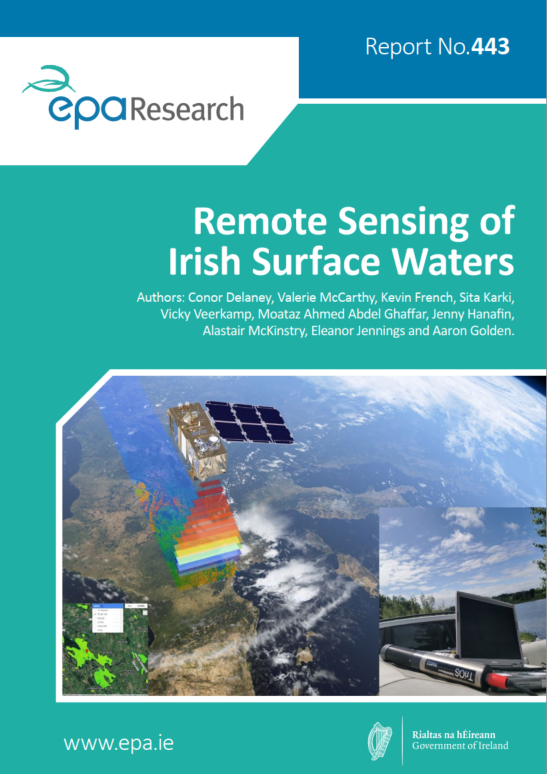Research 443: Remote Sensing of Irish Surface Waters
Authors: Conor Delaney, Valerie McCarthy, Kevin French, Sita Karki, Vicky Veerkamp, Moataz Ahmed Abdel Ghaffar, Jenny Hanafin, Alastair McKinstry, Eleanor Jennings and Aaron Golden
Summary: Lakes, estuaries, and coastal waters are crucial for human well-being. Lakes are critical sources of drinking water, and support irrigation, fisheries, and aquaculture activities. These waters are also important for recreation and tourism and support high levels of biodiversity. The number and diversity of water bodies in Ireland makes regular in situ monitoring an acute challenge for regulatory authorities. Ireland has legally binding legislative obligations under the WFD. This project determined if the use of freely available Earth observation data from both the Copernicus and Landsat Earth observation programmes could offer a cost-effective and evidence-based means of remotely monitoring such water bodies in Ireland.

Projects highlights video
This feature requires cookies. Open your cookie settings.
Identifying pressures
Lakes, estuaries and coastal waters are crucial for human well-being. Lakes are critical sources of drinking water, and support irrigation, fisheries and aquaculture activities. These waters are also important for recreation and tourism, and support high levels of biodiversity. These natural resources are under anthropogenic pressures from eutrophication, inorganic pollution, acidification, invasive species, extraction of upstream water and climate change. Proper management and maintenance of these resources are essential for society, but are also a requirement under national and EU legislation. The number and diversity of water bodies in Ireland makes regular in situ monitoring an acute challenge for regulatory authorities. This project attempts to determine if the use of freely available Earth observation data from both the Copernicus and Landsat Earth observation programmes could offer a cost-effective and evidence based means of remotely monitoring such water bodies in Ireland for stakeholders. This report concludes that such monitoring is indeed possible, although complicated by regular cloud cover and high numbers of small, shallow and high-colour lakes that are difficult to survey remotely using existing Copernicus assets.
Informing policy
A means of improving lake, estuary and coastal water monitoring capacity and frequency on the island of Ireland would significantly aid in the protection and provision of good-quality water resources and increase our understanding of water quality dynamics. In turn, this would improve the management and mitigation of impacted sites, supporting the provision of ecosystem services and ecosystem ecological function. Such a monitoring regime would be invaluable for both policymakers and legislators and enable Ireland to meet its obligations under national and EU legislation.1
Developing solutions
A campaign of ground truth observations of various water quality parameters at selected water body locations, coincident with passes of the Copernicus programme’s Sentinel-2 Earth observation satellites, was implemented. This resulted in the development of an Irish-specific data reduction platform yielding mapped estimates of chlorophyll a and water turbidity, both indicators for water quality, directly from this satellite imagery. The performance is consistent with other European initiatives to assess water quality from orbit. The platform increases the EPA’s potential ability to monitor ~70% of Irish lakes remotely and better optimise existing sampling programmes. This platform uses newly released Sentinel-2 data for Ireland and updates a monitoring map accessible online. Overall, this demonstrated the efficacy of such an Earth observation-based system to monitor Irish lakes, estuaries and coastal water bodies. Satellite observations can, therefore, complement traditional freshwater monitoring in an essentially automatic and cost-effective manner, permitting the optimal use of in situ monitoring logistics to identify and investigate specific sites in a more controlled and evidence-based fashion.
https://www.epa.ie/media/epa-2020/research/research-publications/Screenshot-2023-11-29-103819.png